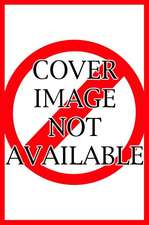Wandering Dixie: Dispatches from the Lost Jewish South
Autor Sue Eisenfelden Limba Engleză Paperback – 31 mar 2020
From South Carolina to Arkansas, she explores the small towns where Jewish people once lived and thrived. She visits the site of her distant cousin and civil rights activist Andrew Goodman’s murder during 1964’s Freedom Summer. She also talks with the only Jews remaining in some of the “lost” places, from Selma to the Mississippi Delta to Natchitoches, and visits areas with no Jewish community left—except for an old temple or overgrown cemetery. Eisenfeld follows her curiosity about Jewish Confederates and casts an unflinching eye on early southern Jews’ participation in slavery. Her travels become a journey of revelation about our nation’s fraught history and a personal reckoning with the true nature of America.
Preț: 117.85 lei
Nou
Puncte Express: 177
Preț estimativ în valută:
22.55€ • 24.11$ • 18.80£
22.55€ • 24.11$ • 18.80£
Carte disponibilă
Livrare economică 28 martie-11 aprilie
Preluare comenzi: 021 569.72.76
Specificații
ISBN-13: 9780814255810
ISBN-10: 0814255817
Pagini: 292
Dimensiuni: 140 x 216 x 30 mm
Greutate: 0.37 kg
Ediția:1
Editura: Ohio State University Press
Colecția Mad Creek Books
ISBN-10: 0814255817
Pagini: 292
Dimensiuni: 140 x 216 x 30 mm
Greutate: 0.37 kg
Ediția:1
Editura: Ohio State University Press
Colecția Mad Creek Books
Recenzii
“In [Wandering Dixie], Eisenfeld's itinerary is both organized and serendipitous. The souvenirs she picks up along the way, like the weeds in so many of the overgrown Jewish cemeteries she visits, amount to a beautifully nuanced and moving portrait of acceptance and accountability.”—Cathy Alter, Washington Independent Review of Books
“[Eisenfeld] grounds her historical analysis in personal reflection as she travels to small towns with lost or vanishing Jewish histories.…Her ruminations highlight both Jewish history and lack of current resources to maintain sites and records.…Her stories provide many revealing tidbits for those who enjoy self-reflective historical writing.” —Publishers Weekly
“A digestible introduction to a specific piece of the history of the South's racial politics.”—Kirkus Reviews
“Beautifully written and highly thoughtful, Wandering Dixie takes us on a powerful journey through the physical and internal landscapes of the South. Eisenfeld confronts religion, race, and reckoning, revealing the powerful vectors in our lives that push us into the unexpected.” —Randon Billings Noble, author of Be with Me Always
“In stunningly elegant prose, Eisenfeld uncovers the anonymous corners of Jewish and Confederate history. In this immersive gem of a book, she inspires hope for a nuanced and vital conversation about race by claiming her own role in ‘our troubled American story.’” —Michelle Brafman, author of Washing the Dead
“[Eisenfeld] grounds her historical analysis in personal reflection as she travels to small towns with lost or vanishing Jewish histories.…Her ruminations highlight both Jewish history and lack of current resources to maintain sites and records.…Her stories provide many revealing tidbits for those who enjoy self-reflective historical writing.” —Publishers Weekly
“A digestible introduction to a specific piece of the history of the South's racial politics.”—Kirkus Reviews
“Beautifully written and highly thoughtful, Wandering Dixie takes us on a powerful journey through the physical and internal landscapes of the South. Eisenfeld confronts religion, race, and reckoning, revealing the powerful vectors in our lives that push us into the unexpected.” —Randon Billings Noble, author of Be with Me Always
“In stunningly elegant prose, Eisenfeld uncovers the anonymous corners of Jewish and Confederate history. In this immersive gem of a book, she inspires hope for a nuanced and vital conversation about race by claiming her own role in ‘our troubled American story.’” —Michelle Brafman, author of Washing the Dead
Notă biografică
Sue Eisenfeld is a freelance writer, communications consultant, and faculty member in the Johns Hopkins University MA in Science Writing Program. Her work has appeared in the New York Times, Washington Post, The Forward, and other publications. She is the author of Shenandoah: A Story of Conservation and Betrayal. Find her at www.sueeisenfeld.com.
Extras
I don’t even have to prompt Hamm to dig deeper; she keeps on talking. “Not that what he did wasn’t horrible,” referring to the day in June 1963 when, in his first term as governor, he literally stood in a schoolhouse doorway, flanked by armed state troopers, to bar the path of two black students attempting to attend the University of Alabama. President Kennedy ordered the National Guard to the campus. Later that year, Wallace ordered state police to four locations to prevent public schools from opening after a federal integration court order, and the civil disturbances that erupted resulted in at least one death.
Some believe his lack of enforcement of civil rights— lawlessness, really—led to the bombing of the 16th Street Baptist Church in Birmingham, which killed four young black girls. In fact, when asked on the Friday before the Sunday, September 15, 1963, bombing what needed to happen for the civil rights problems to end in Alabama, he reportedly said, “What we need are a couple of first-class funerals.”
“It’s disgusting to think he’d have any part of keeping blacks down. But I didn’t know him like that. I don’t know if he was a racist, but the person I knew was real down-to-earth. I see him as a human being, a person.” Some say the true, original Wallace came out again by 1982 at age sixty-three. After being paralyzed by an assassination attempt a decade earlier, he admitted to being wrong about race and was elected for his fourth and final term as governor, supported by a coalition of blacks and carrying all ten of the state’s counties with a majority black population. “We thought [segregation] was in the best interests of all concerned,” he said then. “We were mistaken.”
An employee drops in at the peanut warehouse for a moment, and Hamm jokes around with him. Despite the fact that white planters in Barbour County, where Eufaula is located, owned twelve thousand slaves in the mid-1800s, as far as blacks and whites are concerned today, Hamm tells us, “Nobody will look twice at an interracial couple,” and everyone treats everyone equally. Like this employee, she says, who is black. “He’s as dear to me as my own kin.” Of course she’s the manager and he’s the worker, but I keep my mouth shut.
When bringing us outside and showing us the new trailers that the large farms bring their peanuts in on, she mentions that the poorer farmers can’t afford the new trailers, and they use the older wagons, half the size and pulled by a farm tractor rather than a tractor-trailer. Who are the poor farmers? I ask. Well, they are mostly black, she says, and their farms are smaller. Neither she nor I dive deeper into this disparity.
Hamm harkens back to when she was a kid, when her family ran a clothing store as well as a grocery store and a gas station, serving whites as well as the black community that made up 70 percent of the 1,500-person town of Clayton.
“My whole life, being Jewish, the color of someone’s skin . . . we just didn’t do that. We knew what it was like to be different. We were the only Jewish family in that small town. As a Jewish kid, racism was not in our realm of thinking. We weren’t like that. We felt kinship. We were always on their side.
“It would kill me to say the N-word,” she says.
Some believe his lack of enforcement of civil rights— lawlessness, really—led to the bombing of the 16th Street Baptist Church in Birmingham, which killed four young black girls. In fact, when asked on the Friday before the Sunday, September 15, 1963, bombing what needed to happen for the civil rights problems to end in Alabama, he reportedly said, “What we need are a couple of first-class funerals.”
“It’s disgusting to think he’d have any part of keeping blacks down. But I didn’t know him like that. I don’t know if he was a racist, but the person I knew was real down-to-earth. I see him as a human being, a person.” Some say the true, original Wallace came out again by 1982 at age sixty-three. After being paralyzed by an assassination attempt a decade earlier, he admitted to being wrong about race and was elected for his fourth and final term as governor, supported by a coalition of blacks and carrying all ten of the state’s counties with a majority black population. “We thought [segregation] was in the best interests of all concerned,” he said then. “We were mistaken.”
An employee drops in at the peanut warehouse for a moment, and Hamm jokes around with him. Despite the fact that white planters in Barbour County, where Eufaula is located, owned twelve thousand slaves in the mid-1800s, as far as blacks and whites are concerned today, Hamm tells us, “Nobody will look twice at an interracial couple,” and everyone treats everyone equally. Like this employee, she says, who is black. “He’s as dear to me as my own kin.” Of course she’s the manager and he’s the worker, but I keep my mouth shut.
When bringing us outside and showing us the new trailers that the large farms bring their peanuts in on, she mentions that the poorer farmers can’t afford the new trailers, and they use the older wagons, half the size and pulled by a farm tractor rather than a tractor-trailer. Who are the poor farmers? I ask. Well, they are mostly black, she says, and their farms are smaller. Neither she nor I dive deeper into this disparity.
Hamm harkens back to when she was a kid, when her family ran a clothing store as well as a grocery store and a gas station, serving whites as well as the black community that made up 70 percent of the 1,500-person town of Clayton.
“My whole life, being Jewish, the color of someone’s skin . . . we just didn’t do that. We knew what it was like to be different. We were the only Jewish family in that small town. As a Jewish kid, racism was not in our realm of thinking. We weren’t like that. We felt kinship. We were always on their side.
“It would kill me to say the N-word,” she says.
Cuprins
Contents
Jews, the Confederacy, Race, the South, and Me: A Prologue
Part 1 Road Trip
The Peanut Lady of Eufaula
The Geography of Hope
Defenders of Selma
Part 2 Meetups
A Night in Natchez
All Mixed Up in Gumbo Land
True South
Part 3 Investigation
Where It Begins and Where It Ends
The Longest Memory
Road to Jerusalem
Acknowledgments
Notes
Sources
Jews, the Confederacy, Race, the South, and Me: A Prologue
Part 1 Road Trip
The Peanut Lady of Eufaula
The Geography of Hope
Defenders of Selma
Part 2 Meetups
A Night in Natchez
All Mixed Up in Gumbo Land
True South
Part 3 Investigation
Where It Begins and Where It Ends
The Longest Memory
Road to Jerusalem
Acknowledgments
Notes
Sources
Descriere
A hybrid travelogue/memoir that explores the lesser-known Jewish culture, music, food, and history of the American South.























